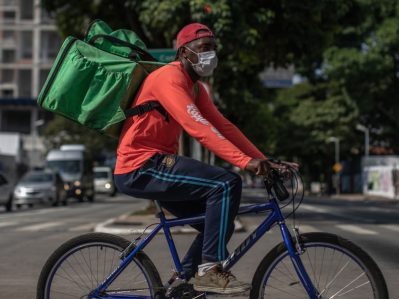Mayor Lori Lightfoot announced a new program to create more space for people walking and biking during the COVID-19 pandemic.
According to the Chicago Department of Transportation (CDOT), the Our Streets initiative “invites Chicago neighborhoods to request that local roads be converted into corridors for improved, safe travel and healthy activity.”
This includes designating some residential streets as “shared streets” by adding traffic barriers and limiting through traffic to allow for physically distanced walking and biking. The list of streets is still in development, although 47th Ward Alderman Matt Martin announced Leland Avenue in his North Side ward will be the city’s first COVID-19 shared street starting Friday.
Shared streets are a first step to help Chicagoans feel safe walking and biking during the pandemic, but much more needs to be done. To date, the city’s plans fail to address the mobility needs of the areas hit hardest by COVID-19. These same majority Black and Brown areas faced the greatest barriers to safe, convenient, and affordable transportation before the pandemic.
A broad range of street design and policy changes is needed to support essential transportation and prevent a dangerous spike in driving. A driving surge would have devastating impacts on the air quality and health of our communities, with Black and Brown communities continuing to bear the brunt of the damage.
We urge city officials to work with residents, community-based organizations, and elected officials to build upon this initial plan with extensive community input. CDOT launched a 4-question survey to collect more input, particularly from high need areas on the South and West Sides.
City data shows most of feedback they’ve received so far has been from relatively White, wealthy, North Side neighborhoods.
COVID-19 MOBILITY RECOMMENDATIONS
Since the start of the crisis, Active Trans has provided input to Mayor Lightfoot, members of City Council, CDOT, the Chicago Transit Authority (CTA), and other agencies on possible interventions to make travel safer and more convenient for people walking, biking, and riding public transit.
The following feedback summary is based on our ongoing conversations with members, supporters, and community-based partner organizations.
Broaden public input. As CDOT acknowledges, the mobility feedback received so far is overwhelming from North Side neighborhoods. The city should introduce new tools to conduct outreach and focus efforts in highest need communities. Tactics may include virtual focus groups, one-on-one calls with community leaders, engagement through aldermanic offices, setting up a text hotline, etc.
Center high-need communities. Neighborhoods hit hardest by COVID-19 include Black and Brown communities like South Shore, Englewood, Austin, Chatham, Auburn Gresham, Austin, Belmont Cragin, Little Village, and Humboldt Park. Before the pandemic, these areas already faced major transportation barriers. Any initiative must include interventions in these neighborhoods. Focus on routes to essential services, e.g., health care, groceries, food distribution areas, testing sites.
Plan around business districts. There’s strong public and political support for helping small businesses and restaurants manage devastating economic challenges. Chicago should introduce interventions that encourage social distancing in retail and restaurant districts throughout the city and improve walk/bike/transit access to and through these areas. Interventions may include expanding sidewalks into parking lanes, new bikeways and greenways connecting residential areas to local businesses, and bumpouts to calm traffic at busy intersections. Any efforts to dedicate street and sidewalk space to restaurants and businesses must not limit mobility and accessibility.
Develop neighborhood toolbox. Chicago should develop a toolbox of possible interventions to share with aldermen, chambers of commerce, and neighborhood groups who can help tailor projects to the local context. Some neighborhoods may be able to conduct outreach and develop initial implementation plans on their own, while others will require more hands-on support from CDOT and other agencies.
Incorporate transit elements. CDOT should work with CTA to incorporate transit elements into interventions on sidewalks and streets. Options may include marking space at bus stops to encourage social distancing, creating more space at bus stops, and making it safer and more convenient to access stations on foot and on bikes. Accelerate implementation of Bus Priority Zones with dedicated lanes, queue jumps, and other upgrades focused on routes serving essential workers on South and West Sides.
Leverage existing programs, resources, initiatives. Interest in walking and biking has spiked during the pandemic and new users are less familiar with existing resources. CDOT and other departments should promote and accelerate progress on its most relevant initiatives.
- Promote a bikeways recovery network that features infrastructure that’s already in place and coming soon, like spoke routes in the Streets for Cycling Plan and new bikeways on Far South Side.
- Accelerate traffic safety improvements on Vision Zero high crash corridors.
- Promote North-South and East-West commuter routes as ways to add additional capacity to the trails — not instead of them.
- Develop a phased approach to re-opening the Lakefront Trail, including requirements to keep moving and non-police city personnel to encourage social distancing.
- Continue to promote Divvy discounts as a COVID response strategy.
NEXT STEPS
Active Trans is conducting extensive outreach across the city and suburbs to gain a better on-the-ground understanding of different communities’ mobility priorities, with a focus on people and places most impacted by the pandemic. And we’re digging into the data on transit ridership, essential workers, and COVID-19 impact to illuminate critical transportation needs.
We’ll continue to share results from this outreach process in the coming weeks with decision makers in the city and suburbs, and our supporters across the region. Email [email protected] or contact staff directly to share your thoughts.
Photo courtesy of Bloomberg.

